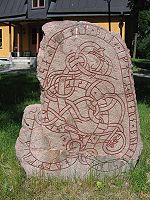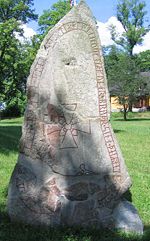
Hagby Runestones
Encyclopedia

Uppland
Uppland is a historical province or landskap on the eastern coast of Sweden, just north of Stockholm, the capital. It borders Södermanland, Västmanland and Gästrikland. It is also bounded by lake Mälaren and the Baltic sea...
, Sweden
Sweden
Sweden , officially the Kingdom of Sweden , is a Nordic country on the Scandinavian Peninsula in Northern Europe. Sweden borders with Norway and Finland and is connected to Denmark by a bridge-tunnel across the Öresund....
. They are inscribed in Old Norse
Old Norse
Old Norse is a North Germanic language that was spoken by inhabitants of Scandinavia and inhabitants of their overseas settlements during the Viking Age, until about 1300....
using the Younger Futhark
Younger Futhark
The Younger Futhark, also called Scandinavian runes, is a runic alphabet, a reduced form of the Elder Futhark, consisting of only 16 characters, in use from ca. 800 CE...
and they date to the 11th century. Three of the runestones (U 153, U 154 and U 155) are raised in memory of Varangians
Varangians
The Varangians or Varyags , sometimes referred to as Variagians, were people from the Baltic region, most often associated with Vikings, who from the 9th to 11th centuries ventured eastwards and southwards along the rivers of Eastern Europe, through what is now Russia, Belarus and Ukraine.According...
who died somewhere in the East, probably in Kievan Rus'
Kievan Rus'
Kievan Rus was a medieval polity in Eastern Europe, from the late 9th to the mid 13th century, when it disintegrated under the pressure of the Mongol invasion of 1237–1240....
.
In 1929/30, they were discovered in the walls of the basement of the farm Litzby, which stood a few hundred metres from Hagby, but which burnt down in the 1880s. The runestones were burnt and fragmented but it was possible to piece 120 fragments together into the four runestones that are found on the courtyard of Hagby today.
There are additional runestones on the property of Hagby, and notably U 143, which is treated in the article Uppland Rune Inscriptions 101, 143 and 147
Uppland Rune Inscriptions 101, 143 and 147
The runestones known as U 101, U 143 and U 147, are located in south-western Täby, in the parishes of Sollentuna and Täby, in Uppland, Sweden. They are all in the style Pr4 and thus dated to the period 1060-1100 during which they were carved in connection with the construction of a road from Hagby...
, and U 148, which is treated in the article Jarlabanke Runestones
Jarlabanke Runestones
The Jarlabanke Runestones is the name of c. 20 runestones written in Old Norse with the Younger Futhark in 11th century, Uppland, Sweden.They were ordered in the by what appears to have been a chieftain named Jarlabanke Ingefastsson and his clan , in Täby...
.
U 152

Urnes style
The Urnes style was the last phase of Scandinavian animal art during the second half of the 11th century and in the early 12th century. The preceding phases of Scandinavia's Viking Age animal ornamentation are usually categorized as Oseberg style, Borre style, Jelling style, Mammen style and...
. This runestone style is characterized by slim and stylized animals that are interwoven into tight patterns. The animals heads are typically seen in profile with slender almond-shaped eyes and upwardly curled appendages on the noses and the necks.
Transliteration
- × hulmfriR × -it --isa × istain × þina × iftiR × biarn × buanta isin × auk × iftiR × isikat (s)un isin ×
Transcription into Old NorseOld NorseOld Norse is a North Germanic language that was spoken by inhabitants of Scandinavia and inhabitants of their overseas settlements during the Viking Age, until about 1300....
- Holmfriðr [l]et [ræ]isa stæin þenna æftiR Biorn, boanda sinn, ok æftiR Sighvat, sun sinn.
Translation in English
- Holmfríðr had this stone raised in memory of Bjôrn, her husbandman and in memory of Sighvatr, her son.
U 153

Transliteration
- ...[(u)](a)i- × [(a)]uk × ulf- litu × raisa × stai-(a) × e(f)tiR × hlftan * auk * eftiR × kunar × bryþr × sina × þaiR * antaþus × aust... ...(u)m
Transcription into Old Norse
- [S]væi[nn] ok Ulf[R] letu ræisa stæi[n]a æftiR Halfdan ok æftiR Gunnar, brøðr sina. ÞæiR ændaðus aust[r] ...
Translation in English
- Sveinn and Ulfr had the stones raised in memory of Halfdan and in memory of Gunnarr, their brothers. They met their end in the east ...
U 154
This runestone is also raised in memory of Varangians who died somewhere in the east, but these are different people from those in the previous runestone and in the following one. U 154 is classified as being carved in runestone style Pr3.Transliteration
- [þ(o)]...r × lit × rai... ... ...fast * auk × at × (k)aiRbiarn × bruþ- ... ...i(R) * (t)o a(u)s... ×
Transcription into Old Norse
- ... let ræi[sa] ... ...fast ok at GæiRbiorn, brøð[r] ... [þæ]iR dou aus[tr].
Translation in English
- ... had raised ... ...-fastr and in memory of Geirbjôrn, (their) brothers ... They died in the east.
U 155
This runestone is raised by the same Sveinn and Ulfr as U 153, above. This stone adds the names of Örn and Ragnfríðr, the parents of the four brothers.Transliteration
- ...n × auk × ulfr litu × rai(s)(a) sta... ... ... ...na × þaiR × uaru × suniR × arnar × auk × raknfriþar ×
Transcription into Old Norse
- [Svæi]nn ok UlfR letu ræisa stæ[ina æftiR brøðr si]na. ÞæiR vaRu syniR ArnaR ok RagnfriðaR.
Translation in English
- Sveinn and Ulfr had the stones raised in memory of their brothers. They were the sons of Ôrn and Ragnfríðr.
Other sources
- RundataRundataThe Scandinavian Runic-text Data Base is a project involving the creation and maintenance of a database of runic inscriptions. The project's goal is to comprehensively catalog runestones in a machine-readable way for future research...
- The article Hagby gård on the site of the local heritage society of TäbyTäbyTäby is a trimunicipal locality and the seat of Täby Municipality in Stockholm County, Sweden, with 58,593 inhabitants in 2005. It is also partly located in Danderyd Municipality and Sollentuna Municipality...
, retrieved June 27, 2007.

